HAL fluorescence cystoscopy and TURB one year of Romanian experience
- PMID: 20108538
- PMCID: PMC3018986
HAL fluorescence cystoscopy and TURB one year of Romanian experience
Abstract
Hexaminolevulinate blue light cystoscopy (HAL-BLC) represents an increasingly acknowledged method in bladder cancer diagnostic. We aimed to evaluate the importance of this procedure in cases of non-invasive bladder tumors (NIBT), to compare it with standard white light cystoscopy (WLC), and to establish the efficiency of blue light transurethral bladder resection (BL-TURB). Between December 2007 and December 2008, WLC and BLC were performed in 70 cases. WL-TURB was performed for all lesions visible in WL, and BL-TURB for those only detected in BL. Patients diagnosed with NIBT were followed-up after an average period of 5 months (between 18 and 22 weeks) by WLC and BLC. The control group included the same number of consecutive cases of NIBT, which underwent only WLC and WL-TURB, as well as the same follow-up protocol as the study group. WLC correctly identified 115 tumors, and BLC, 157 tumors. The detection rate was 68.8% for WLC, with a 9.4% rate of false-positive results, and 94% for BLC, with a 14.6% rate of false-positive results. The diagnostic accuracy in CIS lesions was 57.3% for WLC and 95% for BLC, while in pTa tumors; it was 68.8% for WLC and 94% for BLC. 62 cases of the study group diagnosed with NIBT emphasized a recurrence rate of 6.4% after 5 months. The control group described a recurrence rate of 24.2%. HAL fluorescence cystoscopy is a valuable diagnostic method for patients with NIBT, with considerably improved accuracy by comparison to WLC, and a significant impact upon the short-term recurrence rate.
Figures
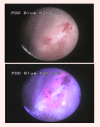
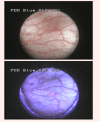
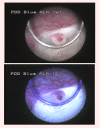
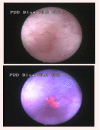
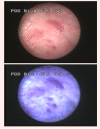
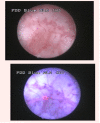
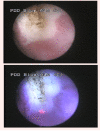
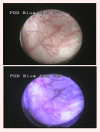
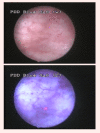
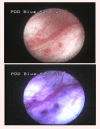
Similar articles
-
Hexaminolevulinate fluorescence cystoscopy and transurethral resection of the bladder in noninvasive bladder tumors.J Endourol. 2009 Jun;23(6):977-81. doi: 10.1089/end.2008.0574. J Endourol. 2009. PMID: 19473068 Clinical Trial.
-
Treatment changes and long-term recurrence rates after hexaminolevulinate (HAL) fluorescence cystoscopy: does it really make a difference in patients with non-muscle-invasive bladder cancer (NMIBC)?BJU Int. 2012 Feb;109(4):549-56. doi: 10.1111/j.1464-410X.2011.10374.x. Epub 2011 Jun 28. BJU Int. 2012. PMID: 21711438 Clinical Trial.
-
Hexvix blue light fluorescence cystoscopy--a promising approach in diagnosis of superficial bladder tumors.J Med Life. 2008 Jul-Sep;1(3):355-62. J Med Life. 2008. PMID: 20108513 Free PMC article. Clinical Trial.
-
Clinical and cost effectiveness of hexaminolevulinate-guided blue-light cystoscopy: evidence review and updated expert recommendations.Eur Urol. 2014 Nov;66(5):863-71. doi: 10.1016/j.eururo.2014.06.037. Epub 2014 Jul 4. Eur Urol. 2014. PMID: 25001887 Review.
-
Hexaminolevulinate blue light cystoscopy: a review of its use in the diagnosis of bladder cancer.Mol Diagn Ther. 2014 Feb;18(1):105-16. doi: 10.1007/s40291-013-0068-x. Mol Diagn Ther. 2014. PMID: 24248555 Review.
Cited by
-
Efficacy and safety of hexaminolevulinate fluorescence cystoscopy in the diagnosis of bladder cancer.Korean J Urol. 2012 Dec;53(12):821-5. doi: 10.4111/kju.2012.53.12.821. Epub 2012 Dec 20. Korean J Urol. 2012. PMID: 23301124 Free PMC article.
References
-
- Oosterlinck O, van der Meijden A. Guidelines on TaT1 (Non-muscle invasive) Bladder Cancer. European Association of Urology Guidelines. 2007:1–17.
-
- Loidl W, Schmidbauer J, Susani M. Flexible Cystoscopy assisted by Hexaminolevulinate Induced Fluorescence: A New Approach for Bladder Cancer Detection and Surveillance? Eur Urol. 2005;47:323–326. - PubMed
-
- Fradet Y, Grossman HB, Gomella L. A Comparison of Hexaminolevulinate Fluorescence Cystoscopy and White Light Cystoscopy for the Detection of Carcinoma In Situ in Patients With Bladder Cancer: A Phase III, Multicenter Study. J Urol. 2007;178: 68–73. - PubMed
-
- Schmidbauer J, Witjes F, Schmeller N. Improved Detection of Urothelial Carcinoma In Situ with Hexaminolevulinate Fluorescence Cystoscopy. J Urol. 2004;171:135–138. - PubMed
-
- Grossman HB. Improving the management of bladder cancer with fluorescence cystoscopy. J Environ Pathol Toxicol Oncol. 2007;26:143–147. - PubMed
MeSH terms
LinkOut - more resources
Full Text Sources
Medical
